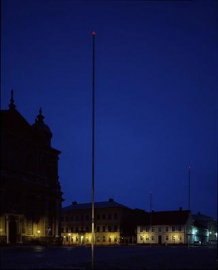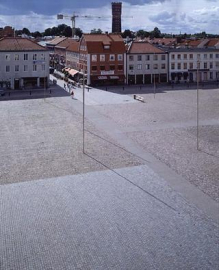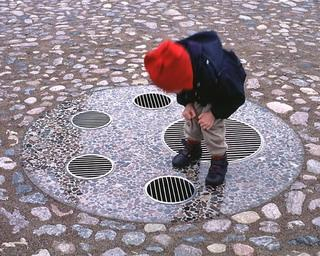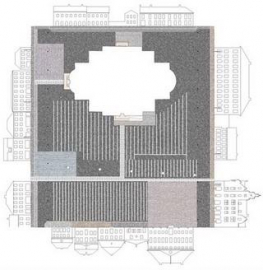Renewal of Cathedral Square, Kalmar
Caruso St John Architects worked with the artist Eva Löfdahl in this project for the renewal of the town square around the baroque cathedral at the centre of Kalmar. Initiated by the Swedish Arts Council it began in 1999 with an international competition. The project is intended to be a model of imaginative renovation in a situation of national historic significance.
During its 300 year history, Stortorget has been a location for political, military and religious representation, for commercial transactions, but most frequently for individual passage, reverie and coincidental meetings. The renewal of Stortoget has not been brought about by the pressure from new functions, but to contribute to a contemporary definition of public space. Concentrating on the physical condition of the square s surface, the design aims to lend dignity to the existing space by increasing one s awareness of its physical characteristics.
The physical history of Stortorget has been about the shifting of stones - field stones from the surrounding agricultural lands stacked into dry stone boundary walls, and then - wall stones providing the raw material to make the streets and square of the baroque town. The presence of field stones at the centre of Kalmar is a reminder of this physical, almost primitive, transformation of rural land into urban place.
The project aims to expand the potential of the square by returning Stortorget to a kind of origin and emptiness once held by the undifferentiated space of the field. The cut granite stones and curbs, laid over the last 80 years to divide cars and pedestrians, are removed to be used elsewhere in the town. Existing areas of field stones are extended to re-establish a level and unitary surface. The practical matters, of easy routes for pedestrians and places for localised gathering, are addressed with smoother areas whose light presence within the surface is like that made by footfall on a beach or after a heavy snowfall. The paths are formed with large pre-cast concrete slabs with a finish of smooth granite pebbles. The range of colours of the aggregate matches those of the field stones so that one surface appears like a miniature of the other.
Further interventions emphasise the dense stoniness of the ground, the nearby presence of the sea, and the airy height of the sky. Below the ground, water flows through a system of connected wells, and the sound of moving water is heard through grilles in the surface. Walking alone or waiting, you are aware of an underlying liveliness, fading with distance to an ambient purl. Above the ground, minerals and gems stones are lifted to stabilise an aerial volume above Stortorget. Tiny red lights are held within the ceiling of the square on surrounding buildings, on the cathedral, and on thin reflective masts. The thin masts, which can sway in the wind, are sandblasted in a banded pattern. They become both sharply defined and subdued, glittering and vanishing. During night and twilight, they establish a close red celestial level over the square.









